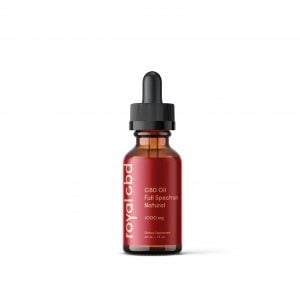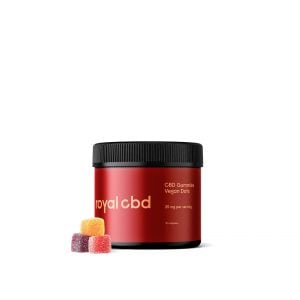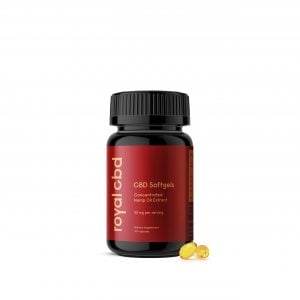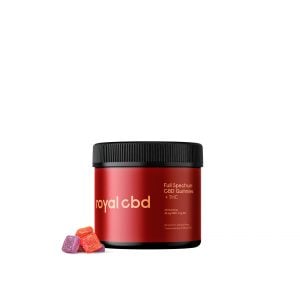If you’re considering using CBD oil for skin, you might have noticed that almost every beauty company has a CBD-infused product in their line-up.
Now, this is either overhyped or there must really be something in the water.
The fact is CBD has a plethora of benefits for the skin, from reducing tension, irritation, and physical discomfort to providing anti-aging effects and replenishing the skin’s protective layer.
But not every CBD oil for skin is the same. In fact, these products differ significantly in terms of quality, formulations, and efficacy.
At Royal CBD, we strive to deliver the best quality of our oils and topicals. We also emphasize education to help our customers make the right choice for their needs.
Here’s a complete guide to using CBD oil for skin. We’ll cover the benefits, uses, and potential risks, and discuss other natural skin care remedies.
What is CBD Oil?
CBD is one of over 100 cannabinoids found in cannabis plants. It’s a close cousin to delta-9-tetrahydrocannabinol (THC) — the compound responsible for euphoric effects in marijuana.
However, CBD doesn’t have intoxicating properties, so it won’t get you high. Most CBD oils on the market are derived from hemp or marijuana — the non-psychoactive species of cannabis — and such products contain 0.3% THC or less. Again, not enough to get you high; not even close.
CBD oil comes in many different concentrations, and people can use it to achieve various health goals. For example, you can take CBD oil for general supplementation to support balance, healthy sleep cycles, proper stress response, etc. But you can also use a topical formulation to address localized discomfort or nourish your skin with cannabinoids, terpenes, flavonoids, and other supportive ingredients (e.g. essential oils, plant extracts, healthy fats).
The reason CBD oil is such a versatile product lies in CBD’s interaction with the endocannabinoid system (ECS). Studies have shown that the ECS regulates many physiological and psychological processes and that the skin has its own set of cannabinoid receptors in its deeper layers.
CBD Oil and Skin: Does CBD Work for Skin Health?
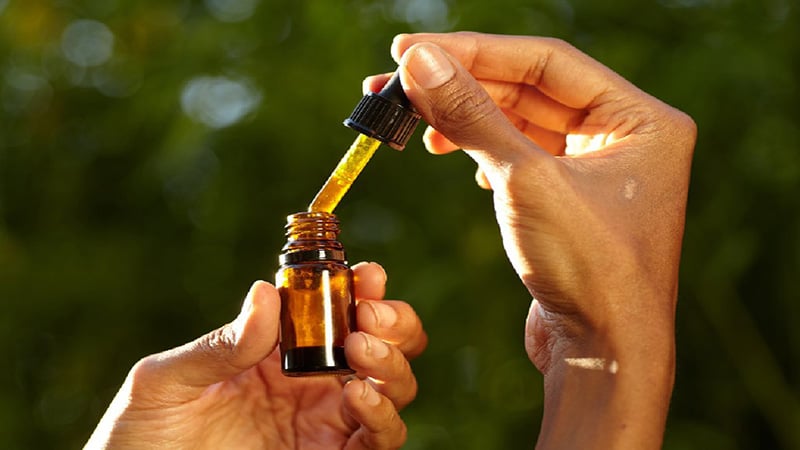
So far, research has brought promising results when it comes to using CBD oil for skin. Please note that due to compliance reasons, we’re not allowed to make health claims about CBD — until the FDA ultimately settles its stance on its efficacy and safety.
That said — wink, wink! — we can tell you a lot about the general benefits of CBD for the skin. From there, you can do your own research and experiment with different products to achieve your goals.
Now to the point. Here’s how CBD works for skin:
CBD vs Skin Breakouts
Skin breakouts, such as pimples, blackheads, and whiteheads, are common skin problems stemming from excessive sebum production that clogs hair follicles and triggers inflammation in the skin.
In a 2014 study, the authors evaluated the effects of CBD on human sebum-producing cells (sebocytes).
Sebum is the oily substance the skin produces. It helps protect our skin, but excessive sebum can also lead to acne. The study suggests that CBD can prevent sebocytes from secreting too much sebum.
A 2016 study highlighted the potential antibacterial and antifungal properties of cannabis. However, the conclusion referred to the whole cannabis plant, not CBD alone.
Finally, researchers in a 2019 study concluded that CBD may be beneficial for reducing the appearance of scars.
CBD vs Aging and Wrinkles
In a 2017 study published in Cannabis and Cannabinoid Research, CBD was acknowledged as a potent antioxidant. Oxidative stress can damage skin cells and speed up aging, so the antioxidative and soothing properties of CBD may help with aging and wrinkles.
CBD vs Dryness and Itching
A 2019 study found that CBD may be useful for reducing dryness and itching. CBD can nourish and moisturize the skin thanks to its interaction with the ECS. It also replenishes its protective barrier by activating the CB2 receptors in the epidermis layer. For that reason, CBD is appropriate for people with sensitive skin.
CBD vs Infections
If the discomfort on your skin is caused by bacterial or fungal infections, cannabis skin care products may come in handy. Cannabinoids, such as CBD and supportive cannabinoids, come with antibacterial and antifungal properties — and so do other hemp compounds, such as terpenes, flavonoids, plant waxes, and additional ingredients in your skincare product.
Is CBD Safe to Use for Skin?
The World Health Organization (WHO) considers CBD safe and well-tolerated by humans. However, some mild side effects are possible when you take too much.
Common adverse reactions to high doses of CBD include:
- Drowsiness
- Fatigue
- Changes in appetite
- Diarrhea
Keep in mind that CBD is a potent inhibitor of metabolic enzymes in the liver, meaning it can interact with medications and supplements. If you take any prescription or OTC medications, discuss the use of CBD oil for skin with your doctor.
How to Use CBD Oils and Topicals for Skincare

CBD products come with instructions on the label and packaging to help you figure out how and when to use the product — and how much to apply it.
CBD oils come in glass bottles with droppers attached to them. The dropper helps you measure out the desired amount of the oil; they typically hold 1mL. Once you’ve squeezed up the oil into the dropper, place it under your tongue — and hold it there for up to 60 seconds. Doing so will improve the absorption of CBD and speed up the onset of effects because the active ingredients pass into the bloodstream through a vast network of tiny blood vessels in your mouth.
CBD topicals are easier to use. You just need to follow the manufacturer’s instructions and apply the product directly to the skin. The amount of the product you’ll need to benefit from CBD depends on its formula, potency, and fat base.
How to Choose the Best CBD Products for Your Skin
The CBD market isn’t regulated by the Food and Drug Administration (FDA), meaning it’s the consumer’s responsibility to research the credibility of CBD vendors and the quality and safety of such products.
When buying CBD oil and topicals for skin, choose products that:
- Contain 0.3% THC or less, in compliance with the 2018 Farm Bill
- Have been tested by a third-party laboratory for CBD content, THC levels, phytochemical profile, and purity (passed tests for heavy metals, microbes, and pesticides).
- Come from companies that haven’t received a warning letter from the FDA
- Have batch-specific certificates of analysis (COA)
- Are made with organic hemp grown on domestic farms
- Contain the full spectrum — or, at least, broad spectrum — of cannabinoids, terpenes, and flavonoids
Other factors you want to consider include:
- CBD potency
- Price or the costs
- The reputation of your brand
- Customer service
- User reviews
Other Natural Plant-Based Skin Remedies
CBD is just one of the plethora of natural remedies that may benefit skin care. Some of these ingredients are also found in CBD-infused topicals, such as creams, balms, ointments, lotions, and roll-on sticks.
Use these ingredients if you want to enhance CBD’s potential for your skin health:
- Aloe vera –aloe vera is a remarkable moisturizer and comes with antimicrobial, anti-inflammatory, and wound-healing properties, as suggested by studies from 2014 and 2017.
- Honey –this ancient superfood has shown anti-inflammatory, moisturizing, and wound-healing properties. A 2016 review found it may also enhance immune function, while in a 2017 review the authors concluded that honey can treat burns and wounds.
- Tea tree oil – In a 2013 review of studies, the authors identified the antibacterial, anti-inflammatory, and wound-healing properties of tea tree oil. Later in 2015, another review was published, touting its anti-acne effects.
- Coconut oil – A 2016 article explained how coconut can moisturize the skin and significantly improve its overall hydration. In a 2019 study, the research team found that coconut oil may protect the skin against inflammation and bolster its protective barrier.
Can You Use CBD for Pet Skin?
Yes, you can use CBD for pet skin because pets, like humans, have an endocannabinoid system. Studies on rats, dogs, and horses, have shown that CBD can support healthy skin and coating, as well as help with physical discomfort, itching, dryness, and redness.
Just make sure your CBD pet oil doesn’t come with any allergens that could further irritate the skin. That’s why we always underline the importance of getting your products from sources that have up-to-date lab reports and are honest about their farming and extraction methods.
CBD Oil and Skin: the Bottom Line
Skin is the largest and most absorbent organ in humans. It’s also regularly exposed to environmental damage and other sources of oxidative stress, such as bad eating habits, not caring about the skincare routine, and comorbid health problems.
If you’re looking to achieve better skin health with the use of CBD — be it for its antioxidative, nourishing, or soothing properties — your best bet are CBD topicals. At Royal CBD, we offer two types of topical products: a cooling balm and icy-menthol roll-on gel. Both products are triple-tested in an ISO-certified laboratory and come with batch-specific certificates of analysis that we send with your order.
Let us know in the comments — or in the product review section — how our topicals and CBD oils have helped you improve skin health.
Sources:
- Oláh, A., Tóth, B. I., Borbíró, I., Sugawara, K., Szöllõsi, A. G., Czifra, G., Pál, B., Ambrus, L., Kloepper, J., Camera, E., Ludovici, M., Picardo, M., Voets, T., Zouboulis, C. C., Paus, R., & Bíró, T. (2014). Cannabidiol exerts sebostatic and antiinflammatory effects on human sebocytes. The Journal of clinical investigation, 124(9), 3713–3724. https://doi.org/10.1172/JCI64628
- Andre, C. M., Hausman, J. F., & Guerriero, G. (2016). Cannabis sativa: The Plant of the Thousand and One Molecules. Frontiers in plant science, 7, 19. https://doi.org/10.3389/fpls.2016.00019 [2]
- Palmieri, B., Laurino, C., & Vadalà, M. (2019). A therapeutic effect of cbd-enriched ointment in inflammatory skin diseases and cutaneous scars. La Clinica terapeutica, 170(2), e93–e99. https://doi.org/10.7417/CT.2019.2116
- Iffland, K., & Grotenhermen, F. (2017). An Update on Safety and Side Effects of Cannabidiol: A Review of Clinical Data and Relevant Animal Studies. Cannabis and cannabinoid research, 2(1), 139–154. https://doi.org/10.1089/can.2016.0034 [4]
- Tóth, K. F., Ádám, D., Bíró, T., & Oláh, A. (2019). Cannabinoid Signaling in the Skin: Therapeutic Potential of the “C(ut)annabinoid” System. Molecules (Basel, Switzerland), 24(5), 918. https://doi.org/10.3390/molecules24050918 [5]
- World Health Organization. (2017). Drugs (psychoactive): Cannabidiol (compound of cannabis). WHO.int. Retrieved from: https://www.who.int/news-room/questions-and-answers/item/cannabidiol-(compound-of-cannabis) [6]
- Hajheydari, Z., Saeedi, M., Morteza-Semnani, K., & Soltani, A. (2014). Effect of Aloe vera topical gel combined with tretinoin in treatment of mild and moderate acne vulgaris: a randomized, double-blind, prospective trial. The Journal of dermatological treatment, 25(2), 123–129. https://doi.org/10.3109/09546634.2013.768328
- Aghmiuni, A. I. , & Khiavi, A. A. (2017). Medicinal Plants to Calm and Treat Psoriasis Disease. In (Ed.), Aromatic and Medicinal Plants – Back to Nature. IntechOpen. https://doi.org/10.5772/67062
- McLoone, P., Oluwadun, A., Warnock, M., & Fyfe, L. (2016). Honey: A Therapeutic Agent for Disorders of the Skin. Central Asian journal of global health, 5(1), 241. https://doi.org/10.5195/cajgh.2016.241
- Pazyar, N., Yaghoobi, R., Bagherani, N., & Kazerouni, A. (2013). A review of applications of tea tree oil in dermatology. International journal of dermatology, 52(7), 784–790. https://doi.org/10.1111/j.1365-4632.2012.05654.x
- Hammer K. A. (2015). Treatment of acne with tea tree oil (melaleuca) products: a review of efficacy, tolerability and potential modes of action. International journal of antimicrobial agents, 45(2), 106–110. https://doi.org/10.1016/j.ijantimicag.2014.10.011
- Sethi, A., Kaur, T., Malhotra, S. K., & Gambhir, M. L. (2016). Moisturizers: The Slippery Road. Indian journal of dermatology, 61(3), 279–287. https://doi.org/10.4103/0019-5154.182427 [12]
- Varma, S. R., Sivaprakasam, T. O., Arumugam, I., Dilip, N., Raghuraman, M., Pavan, K. B., Rafiq, M., & Paramesh, R. (2018). In vitro anti-inflammatory and skin protective properties of Virgin coconut oil. Journal of traditional and complementary medicine, 9(1), 5–14. https://doi.org/10.1016/j.jtcme.2017.06.012
